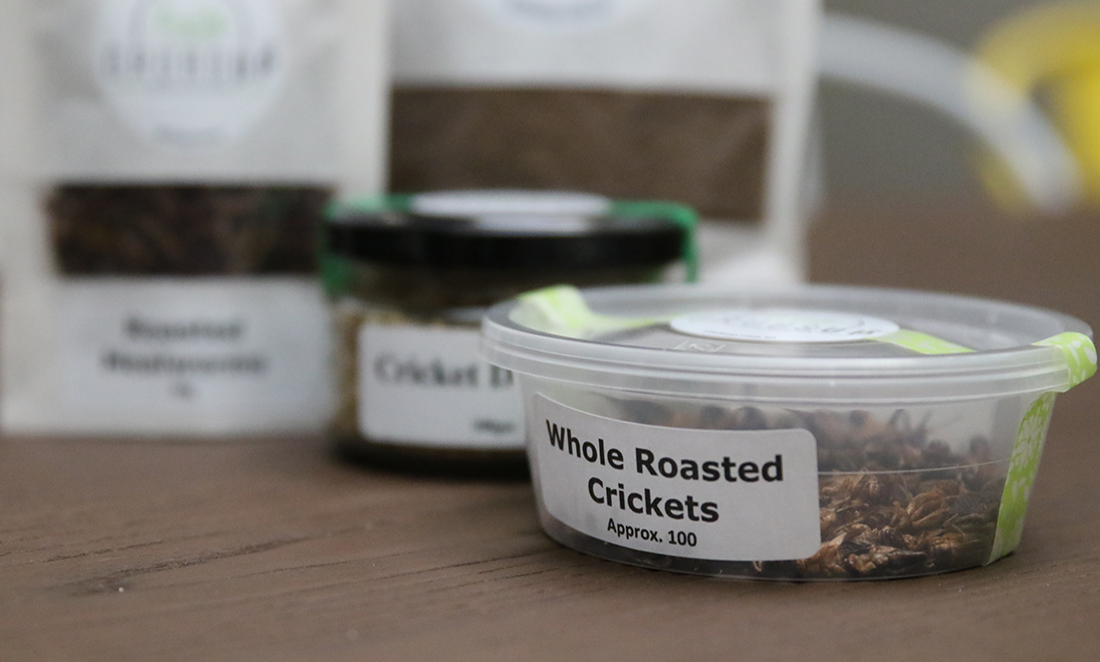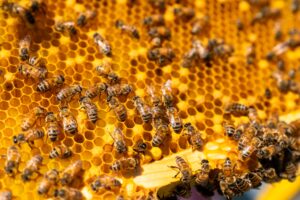Originally, Coolup farmers Paula Pownall and Amanda Abou Rjeily wanted to farm insects for animal feed.
But after a surprising number of enquiries from insect-hungry humans, the business-savvy women realised it was in their best interests to diversify.
Now dishing out crickets and mealworms to insectivorous Aussies, the women behind Grubs Up say, “We’ve seen a huge shift in the 12 months since we’ve been doing business.”

Rather than remaining a novelty snack, insects are metamorphosing into a pantry staple. In November this year, one of the UK’s largest supermarket chains began stocking cricket snack packs.
But perhaps you think that eating insects isn’t for you. Well, we chatted to Amanda to find out why you’re wrong. She even wrote up a recipe for us to show how easy it is to work bugs into your diet.
Grubs up!
BUG BITES
Amanda says that eating insects actually makes a lot of nutritional sense.

“The nutrient profile of crickets is amazing—they’re about 70% protein. Most traditional protein sources are around 30% protein.”
“They also have very high levels of vitamin B12, folate, iron and omegas. And recent studies have shown beneficial prebiotics in their exoskeleton— great for gut health.”
Crickets also contain all nine essential amino acids.
“There’s really no other nutrient profile like it.”
While each edible insect (of which there are 1900 according to the FAO) has a unique nutritional profile, what is true of all insect farms is that they are a beacon of hope for the future of food security.

THE FUTURE OF FOOD
Amanda sees huge potential for insects in a number of ways. “Many parts of the world eat insects as part of their diet. It’s nothing new and revolutionary, it’s just fairly new in a Western mindset.”
Right now, crickets are a premium product. “Because of the scale at which [insects] are being grown right now in Australia, products are at quite a high price point. It’s actually falling into that premium health food market.”
But as time goes on, Amanda hopes that insects will become more of a commodity product—one with the potential to feed our ever-growing population.
“By 2050, there’ll be close to 10 billion people, and we’re going to need to more than double food production in 30 years. We have to think about how we can feed people"
“The nutrient profile—particularly of crickets but of all insects—makes it that you don’t have to consume very much to meet your nutritional requirements. Eating 15 grams of cricket meets your daily protein requirement.”
“We also don’t have to use much space to vertically farm insects, and they’re really efficient at converting resources to nutrient output, so it’s a sustainable option as we move forward.”
STARTUP GRUBS UP
Small children might be willing to put any garden grubs into their gob, but this isn’t the safest way to enjoy a bug banquet.
That’s why it took 12 months for Grubs Up to get approval for human consumption. “There were a lot of hoops to jump through,” reports Amanda.
At that time, they were the first farm in WA to go through the process and only the second in Australia.
Concerns about bacteria “were a huge part of [the hoop jumping]. We’ve got quite rigorous testing requirements in the approvals. And I think a large part of it was fear of the unknown.”
BUSY BEES
In their new business venture, the Grubs Up team considers sustainability at every step.
The egg cartons the crickets spend their short 8-week life cycles happily climbing over are sourced second-hand from local bakeries. The insects enjoy a varied diet of food scraps from the fruit and veggie markets, supplemented with a little calcium to ensure their crunchy exoskeleton grows strong. Occasionally, they are treated to leftover brewers’ mash from local breweries. Even the crickets’ poo gets used as fertiliser.

The bugs aren’t as poop-happy as traditional livestock so there’s only enough to use on the Grubs Up gardens at this point in time. But as their company scales, Amanda says, “That’s something that we’ll have to think about—what do we do with their waste? From the reading we’ve done, we think it’ll make really great fertiliser.”
“Our business and insect farming as a whole has the potential to solve so many different problems.”
Bugging out
Amanda’s biggest bugbear is that farming insects in Australia is such a young practice. Unlike sheep or cattle farming, there’s very little research into what works best.
“Someone once told Paula, ‘Look, you’ve just got to give it a crack, and if you kill a million crickets you kill a million crickets.’ And I can tell you we’ve killed a lot more than a million crickets,” says Amanda.
While there’s a good history of cricket farming in Thailand, the conditions are completely different. “The crickets are kept outside because the climate is so good there.”
“There’s a lot of trial and error,” says Amanda. “We still need to perfect our systems … It’s a bigger picture business at the moment.”
But the lack of solid understanding doesn’t seem to be putting people off. “My email runs hot with people asking how do I start?”
Her answer?
“Do your research, do your homework … It’s fun, but it’s not easy. Know what you’re getting into.”
WHAT’S EASIER THAN FARMING CRICKETS?
Baking cricket gingerbug biscuits! Using cricket powder, these biscuits pack a protein punch—good for you and Santa. If you need to get your feelers on some cricket powder, head to Grubs Up online.

Gingerbug men
Ingredients
380g plain flour
2 tbsp cricket powder
1.5 tbsp ground ginger
1 tsp mixed spice
1 tsp bicarbonate of soda
100g brown sugar
150g golden syrup
150g butter
1 pinch sea salt
1 egg yolk
Method
- Preheat oven to 180°C. Line two baking trays (40 x 35cm) with baking paper and set aside.
- Place all ingredients into a food processor and mix until it resembles find breadcrumbs and starts to come together.
- Transfer dough to a floured work surface and knead into a smooth ball. Place dough into a large bowl and cover. Place dough into the refrigerator and chill for approximately 1 hour.
- Roll out chilled dough between two pieces of baking paper to approximately 4mm thick. Remove top layer of baking paper, then cut gingerbread into desired shapes using cookie cutters.
- Transfer biscuits onto prepared baking trays, then bake 8 to 10 minutes or until lightly browned at the edges. Cooking time will vary slightly depending on the size and shape of your biscuits.
- Allow to cool on trays for 5 minutes, then transfer to a wire rack and leave to cool completely.
- Decorate with royal icing








